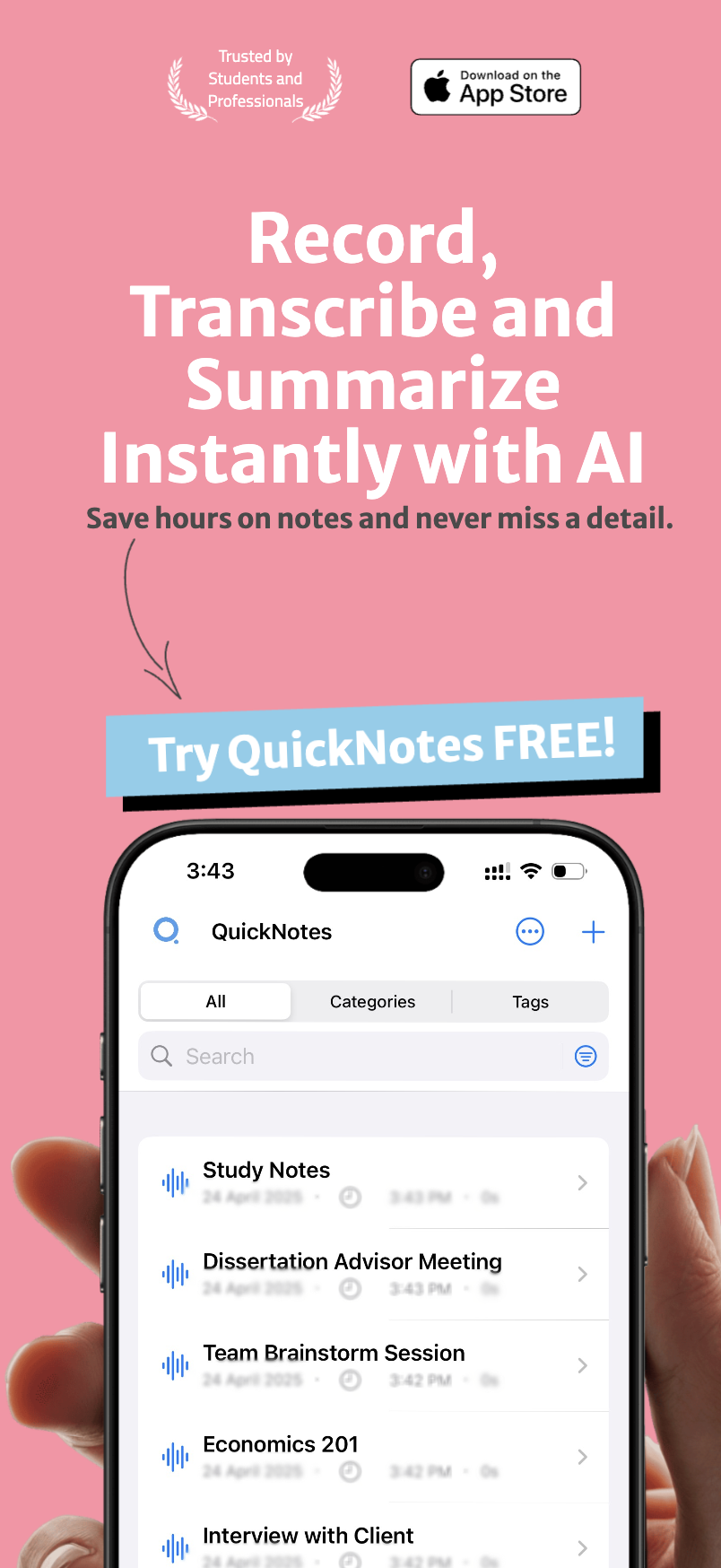Have you ever felt completely overwhelmed by a complex textbook, a lengthy lecture, or a massive project? Information overload is a common challenge in our increasingly complex world. Fortunately, there's a powerful cognitive technique that can help you process, understand, and remember even the most complicated material: chunking.
Table of Contents
- What is Chunking?
- Why Chunking Works: The Science Behind It
- 1. Working Memory Optimization
- 2. Pattern Recognition
- 3. Building on Prior Knowledge
- Chunking Strategies for Different Types of Information
- For Numbers and Sequences
- For Concepts and Theories
- For Procedures and Processes
- For Vocabulary and Language
- How to Implement Chunking with QuickNotes
- 1. Recording and Transcription for Initial Capture
- 2. AI-Powered Summaries for Natural Chunking
- 3. Organization Tools for Hierarchical Chunking
- A Step-by-Step Chunking Process Using QuickNotes
- Step 1: Capture Information Completely
- Step 2: Get a Broad Overview
- Step 3: Create a Hierarchical Structure
- Step 4: Break Down Complex Concepts
- Step 5: Connect Chunks Together
- Real-World Examples: Chunking in Action
- Example 1: Medical Student Learning Anatomy
- Example 2: Business Professional Learning New Software
- Example 3: Language Learner Mastering Vocabulary
- Common Chunking Pitfalls and How to Avoid Them
- Pitfall 1: Creating Arbitrary Chunks
- Pitfall 2: Making Chunks Too Large
- Pitfall 3: Not Reviewing Chunks Holistically
- Conclusion: Chunking as a Lifelong Learning Skill
- You Might Also Like
What is Chunking?#
Chunking is a cognitive strategy that involves breaking down large amounts of information into smaller, manageable units or "chunks." Instead of trying to remember or process a long string of information all at once, you group related items together into meaningful clusters.
This technique leverages a fundamental limitation of our brains: our working memory can only hold about 4-7 items at once. By chunking information, you're essentially condensing multiple pieces of information into single units, allowing you to work with more complex material without overloading your cognitive capacity.
Why Chunking Works: The Science Behind It#
Cognitive psychologists have studied chunking extensively since psychologist George Miller first described the concept in his landmark 1956 paper "The Magical Number Seven, Plus or Minus Two." Research has shown that chunking works for several reasons:
1. Working Memory Optimization#
By packaging related information together, you maximize your limited working memory resources. Instead of trying to remember seven individual digits, you might remember one phone number (which is a chunk).
2. Pattern Recognition#
Our brains naturally look for patterns. Chunking helps identify and strengthen these patterns, making information more meaningful and easier to recall.
3. Building on Prior Knowledge#
When you chunk information, you often connect it to knowledge you already have, creating stronger neural networks and improving retention.
"The essence of chunking is that you're taking individual elements of information and binding them together into a larger unit of information that you treat as a single entity, which significantly increases your ability to remember and understand." — Barbara Oakley, Learning How to Learn
Chunking Strategies for Different Types of Information#
For Numbers and Sequences#
Phone numbers are a classic example of chunking. Instead of trying to remember 10 individual digits (e.g., 5551234567), we break them into chunks (555-123-4567), making them much easier to recall.
For Concepts and Theories#
When studying complex concepts, group related ideas together under meaningful headings or categories. For example, when learning about photosynthesis, you might create chunks for "light-dependent reactions," "Calvin cycle," and "environmental factors."
For Procedures and Processes#
Break down multi-step processes into logical segments. For instance, when learning a new software program, you might chunk commands into categories like "file operations," "editing functions," and "formatting tools."
For Vocabulary and Language#
When learning new vocabulary, group words by themes, roots, or grammatical functions rather than memorizing them as an unstructured list.
How to Implement Chunking with QuickNotes#
Modern technology offers powerful tools to implement chunking more effectively. QuickNotes, with its specialized features, is particularly well-suited for this cognitive strategy:
1. Recording and Transcription for Initial Capture#
The first step in chunking is having comprehensive material to work with. QuickNotes' high-quality audio recording capability allows you to capture lectures, meetings, or your own thoughts completely. Then, using its advanced Speech-to-Text functionality, you can convert these recordings into searchable text.
According to the QuickNotes Functions documentation, the app supports multi-language transcription with automatic language detection, making it versatile for diverse learning environments.
2. AI-Powered Summaries for Natural Chunking#
One of QuickNotes' most powerful features for chunking is its AI-Powered Summaries. The app can automatically identify key points and themes from your transcribed content, effectively creating logical chunks of information for you. With options for short, medium, and long summaries, you can adjust the level of chunking to suit your needs.
3. Organization Tools for Hierarchical Chunking#
QuickNotes offers robust organization features that align perfectly with chunking principles:
- Categories: Organize recordings by customizable categories
- Tags: Apply multiple tags to recordings for flexible organization
- Folders: Group related recordings in customizable folders
A Step-by-Step Chunking Process Using QuickNotes#
Let's walk through how to apply chunking to learning complex material using QuickNotes:
Step 1: Capture Information Completely#
Use QuickNotes to record lectures, meetings, or study sessions. For existing written material, you can import it and use the app to organize and process it.
Step 2: Get a Broad Overview#
Generate a short AI summary of your recording to identify the main themes and concepts. This gives you the highest-level chunks that will form your organizational framework.
Step 3: Create a Hierarchical Structure#
Based on the main themes identified, create categories or folders in QuickNotes to organize your material. For example, if studying psychology, you might have top-level categories for "Cognitive," "Developmental," "Social," etc.
Step 4: Break Down Complex Concepts#
Within each category, use tags to further chunk the information into smaller, related groups. For instance, within "Cognitive Psychology," you might have tags for "Memory," "Attention," "Problem Solving," and so on.
Step 5: Connect Chunks Together#
Use QuickNotes' search functionality to find relationships between different chunks. This helps build a network of knowledge rather than isolated pieces of information.
Real-World Examples: Chunking in Action#
Example 1: Medical Student Learning Anatomy#
A medical student faced with learning hundreds of anatomical structures could use QuickNotes to record lectures, then organize the transcriptions into chunks based on body systems (cardiovascular, nervous, musculoskeletal, etc.). Within each system, they could further chunk by region or function, creating a manageable hierarchy.
Example 2: Business Professional Learning New Software#
A professional learning complex software could record training sessions with QuickNotes, then use the AI summary feature to identify the main functional areas of the software. They could create categories for each module, with tags for specific operations within each module.
Example 3: Language Learner Mastering Vocabulary#
A language learner could record conversations or lessons, then use QuickNotes' multi-language support to transcribe and organize vocabulary. They might chunk words by themes (food, travel, business), grammatical function (verbs, nouns, adjectives), or usage frequency.
Common Chunking Pitfalls and How to Avoid Them#
Pitfall 1: Creating Arbitrary Chunks#
Solution: Ensure your chunks have meaningful connections. QuickNotes' AI summary feature can help identify natural groupings based on semantic relationships.
Pitfall 2: Making Chunks Too Large#
Solution: If a chunk contains more than 5-7 elements, consider breaking it down further. QuickNotes' tagging system allows for multiple levels of organization.
Pitfall 3: Not Reviewing Chunks Holistically#
Solution: Regularly review how your chunks connect to each other. QuickNotes' search function makes it easy to see relationships across your organized material.
Conclusion: Chunking as a Lifelong Learning Skill#
Chunking is more than just a study technique—it's a fundamental cognitive strategy that can transform how you process, understand, and remember information throughout your life. By breaking down complexity into manageable units, you can tackle even the most challenging subjects with greater ease and confidence.
Tools like QuickNotes amplify the power of chunking by automating parts of the process and providing flexible organization systems that mirror how your brain naturally processes information. The app's recording, transcription, summarization, and organization features create an ideal environment for implementing effective chunking strategies.
As information continues to grow exponentially in our digital world, the ability to chunk effectively will only become more valuable. Master this skill now, and you'll have a powerful cognitive tool that serves you in every learning context—from formal education to professional development and personal interests.
You Might Also Like#

AI-Powered Summarization: Extract Key Insights Instantly
Learn how QuickNotes' AI summarization technology helps you extract key insights from lengthy recordings and transcriptions, saving time and improving information retention.

Organization and Tagging: A System for Effective Information Management
Learn how QuickNotes' powerful organization and tagging system helps you categorize, find, and utilize your notes and recordings effectively.

Multi-Language Transcription: Breaking Down Communication Barriers
Discover how QuickNotes' multi-language transcription capabilities can break down communication barriers and streamline global collaboration.

